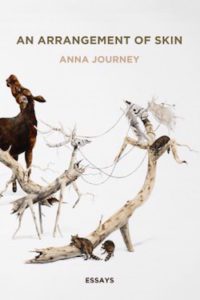
Anna Journey’s collection of essays, An Arrangement of Skin, explores the devastating aftermath of the breakup of a seven-year relationship in the wake of the author’s affair with another man. Here is how she describes what happened:
I’d cheated on my boyfriend of seven years with a poet twice my age, humiliated Carrick by the explosive gossip that ensued, lost one of my best friends, Lee, who was also my most important literary mentor, and felt so wrecked by shame, shock, and a lacerating, self-aimed rage that all I could think to do was to vanish back into Richmond, where I’d once felt safe.
In the first essay, her distress over these events and their catastrophic impact on her personal, professional, and family life is so profound that she calls a suicide line, consumed by guilt, unable to write. A more straightforward memoir might take us step-by-step through the process of putting her life back together, but this is a less direct, more subtle story. Journey approaches this fault-line in her life in archaeological fashion, unearthing the layers of history that surround it, from a long-buried family secret to her glancing acquaintance with the perpetrator of a terrible local crime.
Amid this is material about the body and all the different ways we try to alter and re-form it, from tattooing to plastic surgery to self-harm. Journey develops an interest in taxidermy and describes her participation in classes in which she learns to mount a bird and later a badger. This is the source of the book’s title An Arrangement of Skin, from Greek taxis (arrangement) and derma (skin).
This idea of arrangement is important. Taxidermy involves the presentation of dead animals specifically for display. Implicit in the process is the expectation of their ultimately being seen, whether in a formal setting like a museum, or an informal one like the owner’s home. So a once-living thing goes through a process of being literally disassembled and re-assembled in order to be made to resemble something living again. This serves as a metaphor for what Journey goes through in the wake of her break-up.
For me, the strongest essays in the collection are the ones that deal with the author’s family and community, particularly “The Guineveres,” about her mother. The essay takes its name from a folk group her mother was part of in college, but also touches on her mother’s childhood living adjacent to the grounds of a mental hospital where her father was a resident, her love of telling gruesome stories, her cancer as a young woman, and a terrible spinal injury she suffers when the author is ten years old. The legacy of openness and storytelling that the author receives from her mother is contrasted with the longstanding secret that is another part of her family history—the strong likelihood that her mother’s father was gay and had a long-term partner.
My grandfather would get drunk and drive over, alone, to Jim’s house and stay for hours. My mother believes Jim was her father’s long-term partner, although she never asked either of them about it, even after her father’s death, even after she found the magazines, even after—at the funeral—she saw Jim’s anguished face.
Although at times the sections of the book dealing with taxidermy and tattooing and other related topics might seem unrelated to the more personal material, each deals with this idea of “arrangement” and perception, the way we want things to appear to others vs. the way things actually are.
Tattoos, the creation and removal of scars, and plastic surgery are all ways that we can try to create a body that looks more like the person we feel ourselves to be on the inside. Sometimes, as in the essay “Little Face,” which touches on a plastic surgeon who used Botox so much that he erased all expression from his face, this goes terribly awry. Keeping secrets can be a way of doing the opposite. Journey’s grandfather kept his secret because he lived at a time when he must have felt that it would have negatively affected how he was perceived by those around him. The author invents a ritual to “stop time” because she is so afraid of her boyfriend finding out about her involvement with another man.
At times, it seems the author is holding back, giving us the facts but not the motivations behind them. I wondered what drove her interest in this older poet who she eventually married. Although it’s clear how traumatic this event was for her, I never felt that I truly got to know these two men in her life, or the friend who betrayed her by revealing her secret. My knowledge of them still feels superficial. I couldn’t help but ask myself whether she was holding back to protect them, while her mother freed her to be more honest about her family.
At one point, the teacher of one of her taxidermy courses tells the author the story of how he created a composite polar bear for an exhibit at the Natural History Museum in Los Angeles by taking several old polar bear rugs out of storage, cutting them into hundreds of pieces, and arranging them and gluing them down onto a bear form he’d constructed with his assistant. This is what Journey does in this book, taking all the fragmented scraps that make up her story and arranging them for our consumption. If a piece or two is missing here or there, isn’t it always?




